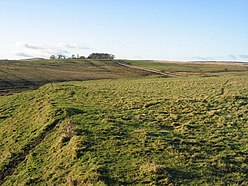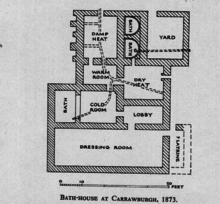Carrawburgh
| Carrawburgh | |
|---|---|
 Southern rampart of Brocolitia | |
| Alternative name(s) | Brocolitia, Procolita, or Brocolita |
| Place in the Roman world | |
| Province | Britannia |
| Stationed military units | |
| — Cohorts — | |
| I Aquitanorum, I Tungrorum, I Cugernorum, I Batavorum equitata, I Frisiavonum | |
| Location | |
| Coordinates | 55°02′10″N 2°13′23″W / 55.036°N 2.223°W |
| County | Northumberland |
| Country | England |
| Reference | |
| UK-OSNG reference | NY858712 |
| Site notes | |
| Controlled by | English Heritage |



Carrawburgh is a settlement in
The name "Procolita" is found in the 5th-century document, the Notitia Dignitatum, and "Brocoliti" in the 7th-century Ravenna Cosmography. The name is probably based on the Celtic name for the place, and one possible translation put forward is 'badger holes'.
Roman fort
Hadrian's Wall was built from 122 AD and most of the wall forts a few years later. Brocolitia was built a few years later still probably to fill a slightly longer gap between forts at
Only the fort's earthworks are now visible, the Wall at this point and the fort's north ramparts having been demolished for the construction of General Wade's early 18th-century military road (now the B6318). The late 19th-century archaeologist John Clayton carried out a partial excavation of the site, revealing a military bath-house outside the fort's west gate (in 1873) and the fort's south-west corner-tower (in 1876).
The Roman Inscriptions of Britain lists 48 inscriptions for the site. They show its garrisoning units to have been as follows:
- Cohors I TungrorumHousesteads
- Cohors I Aquitanorum[5] c. 133
- Cohors I Cugernorum, end 2nd century
- Cohors I
The First Cohort of Frisiavones are also attested at Brocolitia at some stage, as shown by an inscription on an altar stone, which tells us that Optio Maus had repaid a vow to the goddess Coventina. (This unit is also recorded as present at Ardotalia.[10]) Whether this altar was the repayment of the vow is unknown.
Vicus
The vicus (civilian settlement) was just outside the west side of the fort and covered about 4 hectares.[11]
Roman sanctuaries

The remains of three Roman sanctuaries have been discovered in the low-lying marshy ground beyond the fort's south-west corner. All three sites lie adjacent to a small tributary stream of Meggie's Dene Burn, which runs three miles from Carrawburgh to empty into the River South Tyne near Newbrough's fort on the Stanegate.
Nearest to the fort, about 80 metres (260 ft) from its south-west corner, are the remains of an early 3rd century
At Brocolitia, the anteroom and nave were separated by a
Directly in front of the entrance to the mithraeum the remains of an apse, well, and altar were found and named as the Shrine to the Nymphs and Genius Loci, sometimes referred to as a "nymphaeum". Found in 1957 and excavated in 1960, this was the least used temple at Carrawburgh. The Shrine may not have had a traditional building, rather it was a paved and an open air shrine. The altar, dedicated by M. Hispanius Modestinus c. AD 213, was inscribed identically on two sides, and stood on a pedestal indicating it was out in the open, and meant to be walked around.[14] It is likely that this shrine was built during a period of disuse of the Mithraeum as it was located so close to the Mithraic Temple. The building of the second Mithraeum reused materials from the Shrine to the Nymphs and Genius Loci, but preserved the altar. The shrine has a destruction layer around AD 300, roughly the same time as a destruction layer at the Temple to Mithras.[14]
The third site was 'Coventina's Well', a centre for worship of the Romano-British goddess Coventina. This sanctuary, discovered by Clayton in 1876, is the source of the stream. The well is known for the findings of over 13,000 coins, sculptural reliefs, and altars. It was built c.AD128-133, during the construction of the Vallum, in order to help control the water level of the area, it is likely after this it became associated with Coventina with the height of the cult being in the late 2nd to early 3rd centuries[15] when the Batavians were stationed at the fort.
No remains of the nymphaeum or well are now visible.
Ownership
Having been in private hands for many years, the fort, which is a scheduled monument,[16] was gifted to the nation in January 2020 by Jennifer Du Cane, whose family have owned the site since the 1950s. The fort is now in the ownership of Historic England and administered by English Heritage.[17]
References
- ^ Esmonde Cleary, A. "Places: 89128 (*Brocolitia)". Pleiades. Retrieved 28 July 2016.
- ^ Carrawburgh Roman Fort and Temple of Mithras https://www.english-heritage.org.uk/visit/places/temple-of-mithras-carrawburgh-hadrians-wall/history/
- ^ "Roman Britain – Brocolitia".
- ^ RIB 1563b
- ^ RIB 1550
- ^ RIB 1544
- ^ RIB 1553
- ^ Notitia Dignitarum
- Maximinus
- ^ Roman Britain – Ardotalia
- ^ Carrawburgh Roman Fort and Temple of Mithras https://www.english-heritage.org.uk/visit/places/temple-of-mithras-carrawburgh-hadrians-wall/history/
- ^ a b c d Vermaseren, M. J. (1956), Corpus Inscriptionum et Monumentorum Religionis Mithriacae, vol., I, The Hague: Nijhoff.
- ^ a b c d Clauss, Manfred (1992), Cultores Mithrae, Stuttgart: Steiner.
- ^ a b Smith, D.J (1962). "The Shrine of the Nymphs and the Genius Loci at Carrawburgh". Archaeologia Aeliana. Series 4, vol. 40: 59–81.
- ^ Allason-Jones, Lindsay (1985). Coventina's Well: A Shrine on Hadrian's Wall.
- ^ Historic England. "Carrawburgh Roman fort and Hadrian's Wall and vallum between the field boundary east of the fort and the field boundary west of Coventina's Well in wall mile 31 (1015914)". National Heritage List for England. Retrieved 9 January 2020.
- ^ "Hadrian's Wall Roman fort 'gifted to the nation'". BBC News. Retrieved 9 January 2020.



